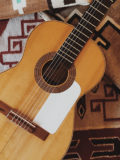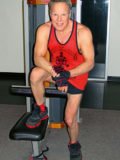By Dr. Larry Stanfel
In 2000 I discovered ballet.
Working on a story about ballet, and wanting technical credibility, I wobbled home from the library with a stack of books on the topic. Quickly I was convinced of the physical strength and endurance, not to mention the mental acuity, these gossamer sylphs must possess and of the complexity of what appear to be simple maneuvers.
After a couple of nights with the American Ballet Theatre in New York, I was infatuated with classical ballet and lamented 61 years wasted without the magical art. It was time to get moving!
The Beginning
The web was a place to begin, and soon I was bombarding the more learned members of an Internet discussion group with my questions. The older hands sought relief by suggesting I take a lesson and see for myself.
When my wife agreed to join me, a good portion of my future was determined. There was no dearth of schools in the Virginia suburbs of D.C., and by telephone I selected two candidates.
Paul and wife, both former performers, advertised instruction in the style of Vaganova, one of the brightest lights in ballet pedagogy, and had a weekly, adult beginners’ class.
Isabelle, a Russian-trained Belgian lady, then 80, spoke English in a mellifluous French accent and also invited us. Her lowest class was more advanced, so we chose Paul.
At a shop I found black, ballet shoes, a black t-shirt, and slinky, black, Lycra-spandex tights, “Unless you’d prefer a leotard,” said a pretty young clerk with calculated mischief. I answered her impertinence with a glare, but it would have been simpler than the damned tights, which covered the feet and had seams to align. After struggling into a sweat, I appealed to my wife, who taught me proper pantyhose technique and, indirectly, sympathy and respect for women that have to use it.
Starting Ballet As Only Male in Class
The school occupied the second floor of a former factory or warehouse, and after we’d climbed the stairs, the other side of the door revealed a huge room well-stocked with attractive, lightly-clad women stretching themselves languorously over barres – “bars,” we would write – and on floor mats.
Every one of about thirty eyes, including Japanese, Russian, and Hispanic, focused on me, the only male – and not a eunuch – in the seraglio. Even at 62 I was welcome. Basking in all the pretty smiles I saw at once I could have run this gauntlet without my wife.
Paul demolished the image of an effeminate male dancer and looked to me more like a street fighter with a long staff he pounded rhythmically on the floor to emphasize the recorded beat.
Everything we did was new, different, and exciting, and I found my reflection handsome in the mildly distorting mirrors; Captain Midnight in soft, ballet slippers. Was I proud? Does Donald Duck have a speech impediment?
Beatings with his stick or verbal abuse were not penalties for imperfection, but Paul pushed us to conform to the book, and the only path to a more advanced class was textbook mastery of the basics. I was determined to pass muster and practiced the five feet positions, along with balancing on one foot or the ball of one foot in church, in waiting lines, in elevators, and in my work cubicle. My wife discouraged these public displays, so I worked out in the kitchen, where the floor was slick and the range, my barre.
The dancer, leaping, seeming to float, spinning, and smiling beatifically all the while, doesn’t appear to be strong, but strength camouflages that sublime movement. You won’t find a ballet dancer that can bench-press 500 pounds, but how many female track stars can point one leg straight up with no more bend than an arrow while standing on the toes of the other foot, and how many football players can balance with one arm a horizontal woman over his head and run gracefully into the wings? Little muscles count, too, and ballet makes those strong.
We loved it all so much, we nearly begged Paul to enter his intermediate class, too, but he said, “No, you’re not up to it,” so we added Isabelle’s class another night each week. She taught the adult beginners herself, and Jane felt badly that she could not raise her own leg as high as the octogenarian’s.
I was good with terminology, but these ten women could execute “pas de basque,” “soubresaut,” “pas de chat,” and other steps that were news to me. I always left that class perspiring, fatigued, and disappointed in myself but always ready for more and exultant at each scrap I learned.
Retiring to Roundup, Montana and Bringing Love for Ballet
As my retirement date approached I calculated that line or square dancing would comprise the dance curriculum at Roundup, Montana. Before moving, nonetheless, I made several phone calls and was excited to find a Billings woman with better credentials than either of our first teachers.
Further, the home we purchased, eleven miles from a paved road, had an unfinished room, and the owner nearly wept when we floated the notion of converting his indoor shop into our ballet studio.
We did it, anyway, and the result would dazzle Agrippina Vaganova, herself. Ranchers that visited were a little uncertain about this anomaly, but, in time, became accustomed to the notion of a man’s doing ballet just as I did to a woman’s shooting targets with a .45 from the back of a galloping horse.
When we met her, new instructor, Julia, had a look at what we could – and couldn’t – do and determined that the best plan was essentially to begin anew.
In ballet the entire body contributes to any step or stance, so it’s simple to see how much territory there is for criticism, and this woman has the visual acuity of a hungry eagle. With a class of two, moreover, she could focus her sharp attention and never miss a fault, of which there were plenty.
It was like having a traffic cop for the parts of our bodies, and thirty-five years of university students would have delighted in the humbling of their demanding professor. We heard “navel to the backbone” so frequently that, for a Christmas present that first year, we gave her a cow vertebra with an orange in the hollow place.
Whereas Isabelle made us weary and sore the next day from attempting complicated jumps, Julia achieves equal pain with elementary exercises. On that subject, Jennifer Penney, a retired star of London’s Royal Ballet, wrote me, “If it doesn’t hurt, you aren’t doing it properly.” My own view is this; think of all the positions and movements with which the body is comfortable; ballet is everything else.
After 14 years teacher and students are good friends, so lessons admit a measure of banter and joking, but, for me, improvement, not having a good time, is the goal, although I have a grand time, anyway. Julia means business, too, and a “good” is a true reward.
Ballet for Health
Is ballet a means to a healthy lifestyle? Isabelle is now 95 and speaks about retiring as a teacher, but we have heard this talk before and are not convinced. Quite a number of history’s premiere dancers have lived into their upper 90s and beyond, and ballet has helped me age well.
I’m more flexible than most people of my years and have better posture and balance. I’m told that I look younger than I am, and learning and remembering combinations of dance steps and entire roles keeps the rust off the brain, too. External forces, however, have raised some speed bumps on my highway.
One occurred in 2005 at lunch with my wife. I suffered two small strokes, precipitated by a heart attack I had thought was a sore shoulder. Accordingly, for one year I was ordered to use oxygen whenever I exercised, and that meant wearing a tank of it on my back and a cannula in my nose for all ballet work.
Can you imagine a fully-outfitted Jacques Cousteau doing dry land pirouettes and jumps? It was cumbersome and hardly aesthetic, but it was the only way to pursue my chosen art, so I did it without (too much) grumbling. Lately I needed new tights and bought some without feet. This has made ballet life much simpler and may contribute to my longevity.
Stage Debut
In 2015, at age 75, I made my stage debut in a rough adaptation of part of a famous ballet, “Coppelia.” As Dr. Coppelius, my task was to animate thirty-one girl dolls between the ages of eight and twelve. In early rehearsals they were shy with a grandfather-like stranger in ballet attire, but I graduated into one of the cast, merrily chiding each other for missed cues and mistakes.
Our six-minute number got lots of applause, and I, the largest and oldest person on stage, a bouquet of lilies, not for my prowess but for my age. I believe I demonstrated to my Montana neighbors that ballet is every bit as respectable as bulldogging and calf roping.
While waiting backstage for the curtain call, a nine-year-old blond in our ensemble asked me, “Just how old are you?”
“Oh, I’m very old.”
“Are you forty-four?”
“No, older than that.”
“Forty-three?” At this point I revealed to her the mystery of my age. “Why, you’re older than my grandpa.”
“Yes, Eleni, I’m older than most people.”














